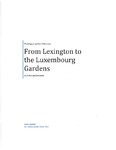From Lexington to the Luxembourg Gardens: An Artist Rediscovered (thesis)

View/
Author
Gephart, Kathryn Bradley
Subject
Washington and Lee University -- Honors in Art History
Anderson, Ellen Graham, 1885-1970
Art, Modern
Twentieth century
Virginia -- Lexington
Metadata
Show full item recordDescription
Thesis; [FULL-TEXT FREELY AVAILABLE ONLINE] Kathryn Bradley Gephart is a member of the Class of 2011 of Washington and Lee University. "Modern," as it applies to art, is a convenient catch-all term but hardly descriptive of anyone trend or style. Towards the end of the nineteenth century, innumerable painters, sculptors, and decorative artists emerged simultaneously with varied creative priorities. Indeed, art historians draw from a vast array of cultural trends and social conditions to derive what makes art from this period "modern." Often, this term generates ideas of the avant-garde, the cosmopolitan, and the forward thinking. In Paris, the veritable cutting edge of the modern art movement, these traits are certainly applicable. Virginia artist Ellen Graham Anderson (1885-1970) was one of many American expatriates working in Paris in the early twentieth century who sought out training and experiences different from what the United States had to offer. However, the schism between the rural traditions of America and the nexial avant-garde movement of Europe seems terribly immediate. Anderson was in Europe at the height of the modern art movement: she studied, worked, and lived in Paris from 1913 until the outbreak of World War I. Here, she had access to art movements such as Art Nouveau, PostImpressionism, Cubism, as well as various Secessionist movements of Expressionism. Upon her return to Lexington, Ellen Anderson continued to paint, and her subsequent canvases and pen and ink drawings demonstrate her internalization of the artistic trends she saw in Europe. Most interestingly, she adapted these themes to the iconography she had access to in Lexington, Virginia. Her renderings of still life scenes, landscapes, and portraits show a strong understanding ofthe aesthetic principles of the French avant-garde, and while abroad Anderson was exposed to the work of many prominent French artists. Yet she was unwilling to divorce her oeuvre from a strong sense of Virginia so deeply instilled in her by her southern family and heritage. Her story parallels those of many other women artists at the turn of the century, and the rediscovery of her experiences and artwork helps to provide a voice for those other artists overlooked by history. [From the Introduction] Katie Gephart
Collections
The following license files are associated with this item: